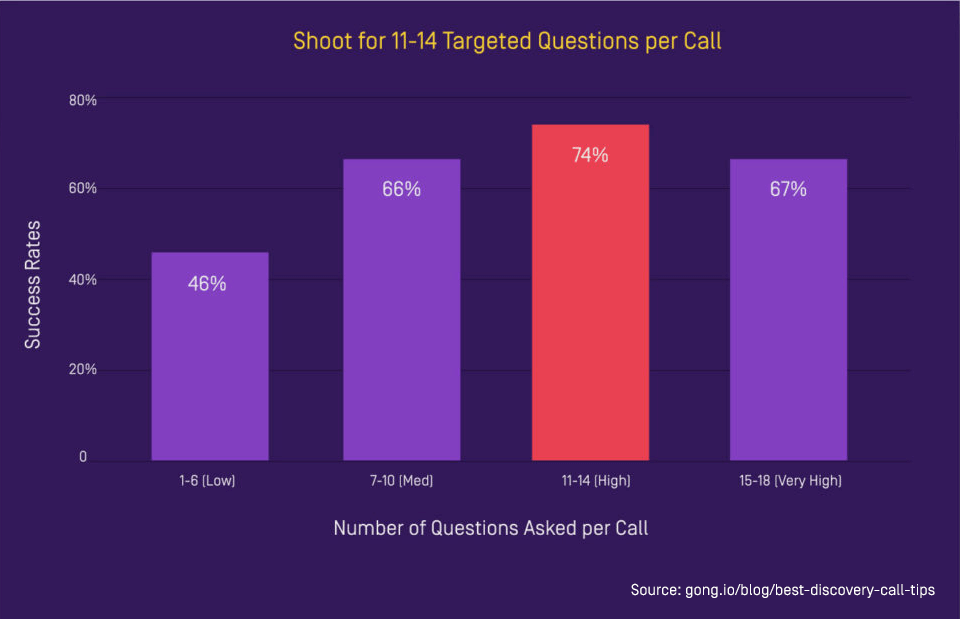Effective sales call planning: Strategies and tips
You might win your next sales call before it even starts.
No, it isn’t a new “sales hack”.
Yes, I’m talking about sales call planning.
And it’s what separates the best reps from the rest. Here’s what I mean:
You’re not just making a sale, you’re building a relationship, one that you hope lasts a long time. This is why even if you don’t make a sale on that first call, showing that you’re invested and interested in learning about your buyer and their needs puts you in the best position for future success.
Here’s what you need to give you the best chance at building that relationship and achieving success in all of your sales calls.
Sales call planning tip #1: review account history
Getting involved early on is the key to winning a sales call.
The sooner you can get your foot in the door, the better. But many salespeople don’t realize that it’s not just about being first.
You also need to be able to influence your buyer’s preferences in your favor. And the best way to do that is by teaching them about a problem that only you can solve. Do that before you even introduce your strength.
This video is a great example.
By getting involved early and showing your buyer how you can solve their unique problem, you’ll be able to box out the competition and win the deal.
Sales call planning tip #2: check for recent activity
As a sales professional, one of your main goals is to identify opportunities and create relationships with potential buyers. But where to start?
One way to get insights into potential deals is to check for recent activity on your CRM and Sales Engagement tools.
For example, if you see two executives have been exchanging emails after an event, you may be able to get an executive sponsor involved in your deal.
Try “multi-threading” the relationship to increase your chance of securing that executive sponsor.
Multi-threading is the concept of building relationships with multiple stakeholders within your deal.
Top sales professionals use an approach in every deal to build momentum and strengthen their influence when they’re not around.
So next time you’re looking for leads, check for recent activity on your tools. It could be the key to landing a major deal.
Sales call planning tip #3: identify competitors
Identifying your competitors is a big part of the business research process. But what’s the best way to go about it?
Well, you can first look at their industry and see who their largest competitors are, then check to see if any of those competitors are already your customers. If so, great! You’ve got insight into how potential customers might view your business.
You’ve also got to be prepared to have names already identified before you make a call.
When it comes to sales call planning, social proof can be a powerful tool.
Here’s the best video on the Internet you’ll find on selling with social proof:
If we see others succeeding, we’re more likely to want to follow in their footsteps.
For social proof to be truly effective, it needs to be relatable. There’s really no point in showing off how successful you are if your prospect can’t imagine achieving the same level of success themselves.
Show you understand and share your prospects’ challenges. Only then will they be able to see you as a trusted partner who can help them overcome those challenges and achieve success.
Sales call planning tip #4: scour public company news
When sales call planning, spend some time combing news articles and press releases for any significant updates, initiatives, hires, or changes.
A compelling event is a business deadline that creates urgency around certain problems you help customers solve.
Sales professionals can use this planning technique to their advantage by creating a sense of urgency around the potential customer’s need to solve their problem.
This can be done by finding out about internal deadlines or changes within the potential customer’s organization and understanding their specific objectives.
Used right, it can give a solid reason to explore new solutions.
Researching company news can also help you avoid possible pitfalls such as accidentally touching on negative topics the company might have been in the news for.
Sales call planning tip #5: know company organization
This is obvious to say, but if you’re not looking up the company organization and personal reporting structures on LinkedIn first, you’re starting at a massive disadvantage.
Knowing a company’s organizational structure, which team the person you’ll be speaking to is on, and who they report to is hugely important. Who are the decision-makers in the company? These are the people you really need to connect with while avoiding voicemail purgatory.
Decision-makers hold the key to success for any deal. However, it’s important to remember that decision-makers are busy folks with a full-stack calendar of meetings. They also might have delegated decision-making to one of their staff.
It pays to never make assumptions until you have a decent lay of the organization land.
Once you have identified the right person, be prepared to address some key top-of-mind questions that they’ll have. Such as:
- How does this deal affect my strategic goals?
- What’s the time to value?
- Who is going to own this?
By prepping with these questions, you’ll be able to pique the interest of the decision-maker and move closer to a successful deal.
Sales call planning tip #6: leverage Linkedin
LinkedIn can be valuable for understanding your buyer when sales call planning. You can learn things from their profile that can help you make a connection and create a sales pitch that resonates.
For example, you can see how they frame their expertise and role and understand their company’s pain points. This will give you an idea of what matters to them now, and you can use this information to prepare your presentation. This information can be helpful when you’re trying to establish a rapport and build trust.
You’ll be able to cater directly to their pain points, which will make your sales call more effective.
The next time you browse your activity feed or notifications, look closely at the comments underneath your connections’ posts. Many people interacting with your prospects and customers will be potential good leads for your product — and they’re clearly active on LinkedIn.
Ultimately, your buyer’s words will always carry more weight than your own, so it’s essential to use their language when possible.
By taking the time to understand your buyer, you can create sales calls more likely to result in a successful outcome.
Sales call planning tip #7: set the agenda
Setting an agenda before a call serves two legit purposes:
- It saves time at the start of the call introducing participants.
- It gives a clear understanding of who will be attending so buyers know if they should include a team member (think a technical counterpart if an SE is joining the call).
Use agenda-setting as a reminder to reduce no-shows by allowing buyers to reschedule if last-minute conflicts have appeared on their calendars.
Would you rather be ghosted or rescheduled?
Setting the agenda also gives potential buyers a chance to add items to the schedule before the meeting kicks off. You’re allowing them to be a part of the process, and that flexibility can go a long way in showing your willingness to hear all of their needs, concerns, and questions.
Sales call planning tip #8: plan your discovery
Understanding your potential buyer’s specific needs is essential.
To do this, you need to ask the right questions. This isn’t always as easy as it might seem. Mistakes do get made, and it isn’t unheard of for sales professionals to come off as running an interrogation with question after question rather than just…taking the time to listen.
Then again, listen too much and fail to ask the right questions to uncover the prospect’s pain points and that could hurt as well.
To strike the right balance, use some of these discovery questions to help you uncover your prospect’s business needs and pinpoint their real pain:
- How is this presenting itself as a problem to the business?
- How are you currently addressing [pain/problem]?
- Where does solving [business challenge] sit on your priority list?
Aim for a sweet spot between 11 and 14 targeted discovery questions per call:

Sales call planning tip #9: organize your resources
Have you ever been on the receiving end of a sales call where the person pitching was disorganized? Highly likely.
They probably didn’t get your business if so.
Do your spot checks like ensuring everything is working (Internet, documents are open to the right page, your mic works, environment is calm…you know, the basics.)
Go into the call with a clear understanding of exactly what you want to achieve in the call. What are your goals? What do you want the prospect to take away from the meeting? Keep these things in mind as you structure your presentation and build around them.
Sales call planning tip #10: decide on the next steps
Know what you want to have happen after the call ends even before you start the call.
Securing a deal is rarely done in any first conversation. It takes time, relationship building, loads of planning, and tons of patience.
You’re climbing a ladder with a secured deal at the top. That first rung has a specific outcome as does each following step up. Know what each of them are.
The better prepared you are for each step up the more you’ll be able to relax along the way and build rapport with your prospect without fear of making mistakes, which improves your chances of securing a deal.
It’s worth it.
Take your sales call planning to the next level with Gong
This sales call prep checklist has every winning sales call planning recommendation summarized, and presented in a simple pdf for your convenience.
Download it. Print it. Share it (or keep it for yourself).
Check it out here, and go secure some deals. You’ve got this.
